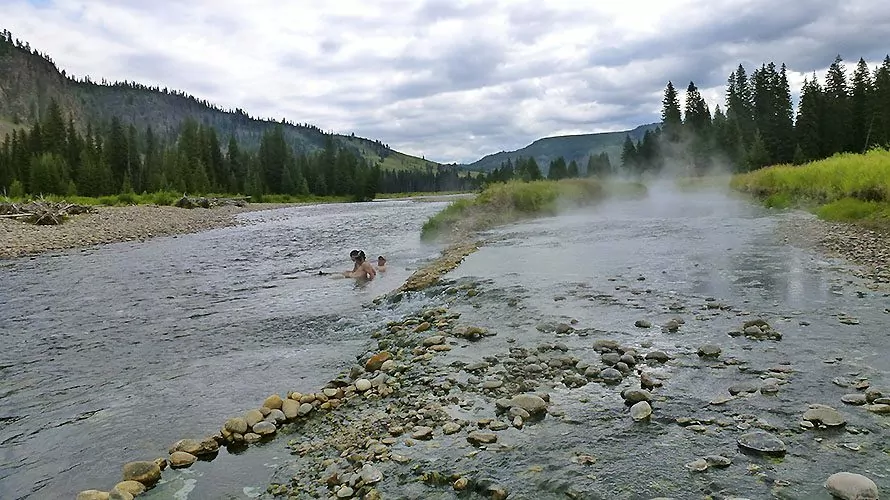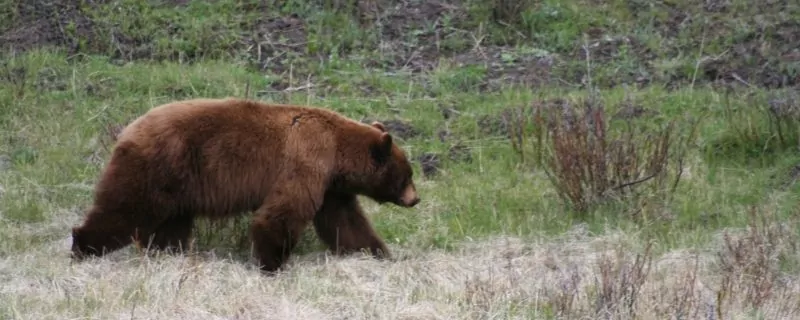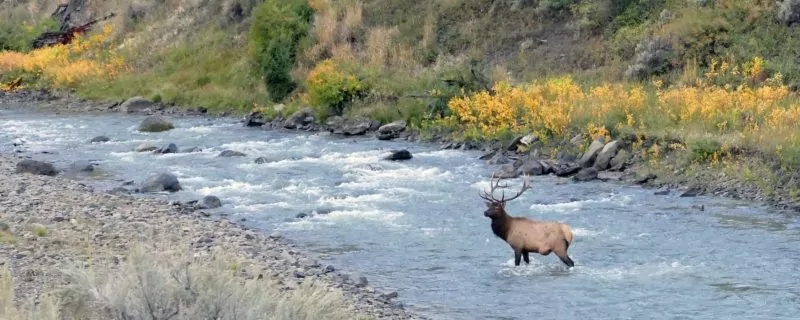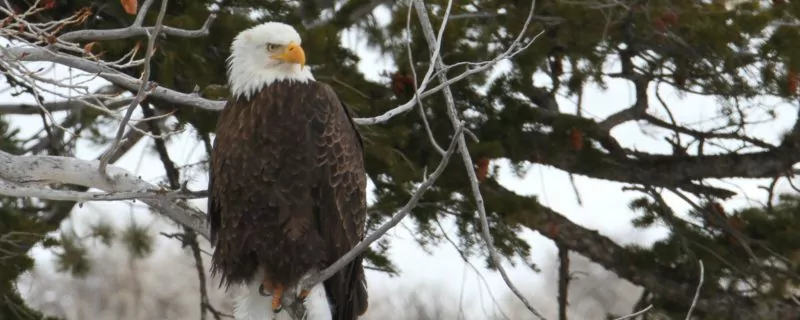
South Boundary Trail
General Description
The South Boundary trail thrusts you into a wilderness adventure right off the bat. It starts by crossing the 30-foot wide Snake River, a serious task with early season runoff. Next, you’ll walk along a small lake, open meadows, and a smattering of thermal features. From there, most of the trail is an old growth forest corridor teaming with berry bushes and mushrooms. There’s no wonder why this area has one of the highest Grizzly bear populations in the park. Finally, the forest opens up and the Snake River is alongside you once more. There is a spot along the river where you can safely soak in the runoff from the Snake Hot Springs. Follow our description to your private back country spa.
Explore Yellowstone with Expert Guides
Getting to the South Boundary Trailhead
The South Boundary Trailhead is located just north of the South Entrance gate in Yellowstone National Park. Parking for the trail is located at the Snake River Picnic Area. Click here for directions to the trailhead. There are restrooms but no water at the picnic area.
Fauna of the South Boundary Trail
Bears
This area offers prime food sources for both grizzly and black bears. They can be found in the forests eating mushrooms, huckleberries, and white bark pine nuts. You might also see them in the meadows eating biscuitroot and horsetail. If they are splashing in a lake or river, they are probably trying to scoop up cutthroat trout or algae. The Red Mountains, including Mt. Sheridan, offer the alpine habitat of their most calorically dense food source, army cutworm moths. You can sometimes spot them along the mountainside, turning up rocks to lick up these fattening insects. If you see a bear, they will most likely be eating.
Sandhill Cranes
You will most likely hear a sandhill crane before you see one. They have a distinct guttural call that can be heard more than 2 miles away. It may take you a minute to distinguish them, as their gray feathers are designed to blend in with their grassy roosts. The grasslands and wetlands along the South Boundary offer perfect habitat for these charismatic birds. When you finally get a good look at them, you’ll be impressed with their slender 4-foot-tall figure. As the tallest birds in Yellowstone, they are sometimes mistaken for people standing off in the distance.
Moose
Moose are a rare sight in Yellowstone. Habitat loss and hunting outside the boundaries have brought their numbers below 200 in the park. However, the old growth forests and wetlands around the South Boundary area make this trail one of the most likely places to spot them. They are usually seen around meadows, rivers, and lakes. Keep your distance though! They are notorious for protecting their territory with brute force.

Day Hiking on the South Boundary Trail
| Destination | Miles | Elev | Difficulty | Style | |
| Snake Hot Springs | 11.2 mi | +/-350 ft | Strenuous | Out and Back |
Snake Hot Springs
This day hike has all the merits of a backcountry adventure: Big mileage, a river ford, off-trail route finding, and virtually complete solitude. From the trailhead sign, you will wind through tall reeds for about a minute before reaching the edge of the Snake River. This water can be around 3 feet deep in July. Unbuckle your hip belt, face the current and cross carefully at an upstream angle. There are reflective orange signs marking the trail on both ends. The next mile crosses wet meadows, a lake, and several small thermal features. From there, you will enter a shaded tree tunnel of old growth Lodgepole pines, spruces, and firs. The forest floor is bursting with wildflowers, berries, and mushrooms. You will cover slight elevation change here and there.
After about 4 miles, the forest opens up and the trail runs parallel to the river. Continue about a half mile to check out the Snake Hot Springs themselves. You will cross a footbridge over a small thermal stream. Shortly thereafter, there will be 2 large steaming pools to the right of the trail. If you’ve reached campsite 8C1, you’ve gone too far. Look for social trails through the tall grass to reach the hot springs. Admire the unique colors, patterns, and textures but be extremely careful not to step too close.
When you’re done admiring the hot springs, return to the trail. It’s time to find the well-hidden soak spot. The small stream you recently crossed via bridge is being fed by thermal water from the Snake Hot Springs. The point at which the hot stream and cold river meet will be your soak spot. You need to plant yourself on the land between the stream and river. From where you are now, look North at the land between you and the river. You are already on the right side of the stream so just walk toward the river a few paces and turn left heading West. There should be a social trail in the grass. However, it changes with regrowth every year. As long as you are walking West with the thermal stream on your left and the river on your right, you will end up in the right place. Be mindful not to step on any major vegetation as you travel off trail. At one point, you will cross a thin branch of dry river bed to get to the next bit of land in front of you. Continue West and the land bar will continue to get narrower. When there is no more land to walk on and these bodies of water rejoin before you, you’re there.
You’ll see the branch to your left is steaming hot and not safe to touch. Where the stream and river meet, there are a couple rock pools built up that are also extremely hot. The temperature immediately downstream of them is heaven. Sit down and soak it up! In August, it is usually necessary to lay down if you want to be fully immersed. By September, the water level can be entirely too low for soaking. Be careful not to step too far into the Snake River as there’s always risk of being swept away.
When you’ve had your fill, retrace your steps back through the social trail to limit the impact on the vegetation. Return to the proper trail and head back the way you came. The tree tunnel has a lot of bear food and low visibility. Aim to finish your hike before dusk to avoid a dangerous encounter. Because of the long mileage, route finding, and soak time, you should plan for this hike to take you all day. Unless you’re into 25-mile days, this out and back is really the only good day hike option for this trail.
Maximize Your Visit to Yellowstone National Park on a Hiking Tour
Guided day hike tours and multi-day packages allow visitors the opportunity to make the most of their time in Yellowstone National Park and to do it hassle-free. Guided tours include gear (backpack, trekking poles, crampons in winter), meals, accommodations on multi-day tours, local transportation, and a professional Yellowstone hiking guide. Through their knowledge, stories, and personal passion, guides can bring a place to life in a way that’s much more difficult to do on your own. Read more about Yellowstone Hiking Tours.
Award Winning USA Hiking Adventures

3 South Boundary Trail Backpacking Trips
The South Boundary trail has backpacking options ranging from an overnight “out and back” to a 5+ day thru-hike.
| Route | Miles | Difficulty | Campgrounds | |
| Snake Hot Springs | 11.2 mi | Easy | Search the Snake River area of the Backcountry Trip Planner | |
| Snake River/Basin Creek Loop | 27.2 mi | Moderate | Search the Snake River area of the Backcountry Trip Planner | |
| Heart Lake to South Boundary | 23.6 mi | Moderate | Search the Heart Lake and Snake River areas of the Backcountry Trip Planner |
1. Snake Hot Springs (2-3 days)
This trip offers all the rewards of our Snake Hot Springs day hike with the slower pace of a backpacking trip. Follow the description above. If you are planning an overnight, you can either visit the hot springs that afternoon when you arrive or the next morning before you leave. Either way, it is safer to visit the hot springs with just day hike essentials leaving your food and backpack weight at camp. Take the utmost care in bear-proofing your camp before this excursion.
You will either stay at 8C1 or 8C6. 8C6 is a mile further after the next Snake River ford. 8C1 is gorgeous and closer to the hot springs, but a bit inconvenient for using the bathroom. Leave No Trace ethics require cat-holes be dug at least 200 yards away from any water source. This site is so close to the river that it is necessary to climb the hill into the forest to make your deposit. As scrambling off trail into a Grizzly rich forest poses extra risks, we recommend a bathroom buddy system. Just stand nearby, facing away from your pooping friend, making occasional bear calls. No need to hold hands for the task.
Our favorite way to plan this backpacking trip is to spend 2 nights out with a full layover day at the same site. You can sleep in, take your time exploring, and spend as much time as you want soaking. Lounging along the river just east of 8C1 is a lovely past time, sure to earn you a visit from the Marmots living underneath the rocky bank. If you have more time to kill that afternoon, you can stroll Southeast along the South Boundary trail or Northeast up the Heart Lake trail. There is beauty in all directions.
2. Snake River/Basin Creek Loop (4-6 days)
Venture deeper into Yellowstone’s southern backcountry with this lollipop shaped route. Start with the South Boundary trail as we’ve described above. At your first junction 5.6 miles in, turn right to continue Southeast along the South Boundary trail. 2.7 miles later, turn left at the junction onto the Snake River trail. This will soon head North offering beautiful riverside views. Continue straight past the next 2 junctions. After 7.8 miles of the Snake River trail, you will join the Heart Lake trail. Turn left (South) here to reach Basin Creek Lake. To complete the loop, continue South climbing small hills and passing gorgeous wetlands. Keep your eyes peeled for moose and sandhill cranes! After 4 miles, you will ford the Snake River. Just a half mile further and you will return to your first junction with the South Boundary trail. On familiar terrain once again, follow the stick of this lollipop back to the trailhead.
For all variations of this trip, we recommend starting off by visiting the Snake Hot Springs. We like having shorter mileage at the beginning of our trips when our packs are heaviest. For night 2, 8C4 along the Snake River is the best. 8C2 at Nine Mile Meadows is a good back up option but it will lengthen your next day by 3.2 miles. Our favorite Basin Creek Lake site is 8B2 for its beauty and proximity to the lake. The trees bearing the food pole here have menacing bear scratches on them. We appreciate this omen as a friendly reminder to keep a neat, clean, bear-proof camp.
To hike this route in 4 days, you will have 3 days that are 5 to 6 miles and 1 day that will be 10 miles or more. To pick your sites, decide whether you’d prefer to hike 10+ miles on your 2nd, 3rd, or last day. Of course, the backcountry office will ultimately make that decision for you. A 5-day itinerary perfectly spaces out the best sites between 5 and 6 miles. The 6-day option is our favorite as it offers the same daily mileage as the 5-day, but with an added layover for a full day of lounging around the Snake Hot Springs.
3. Heart Lake to Snake River Thru Hike (5-6 days)
This route is one of the best backpacking trips in the park. It is easily the best way to enjoy the highlights of the South Boundary trail while adding a ton of variety for a holistic Yellowstone experience. We consider the Snake Hot Springs to be the perfect climax, so our recommended route is North to South.
Start from the Heart Lake trailhead into a thick Lodgepole tree tunnel. After several miles, your view will open up to mountains, a geyser basin, and a far-off lake. The trail will zig zag down several hundred feet and you will pass through three miles of thermal features. The most exciting hot springs are well-visible from the trail. After 7.3 miles you will reach the Heart Lake Patrol Cabin and the gorgeous shore of Heart Lake. Your first camp should be any one along the West shore of the lake.
If you have time for a 6-day itinerary, spend 2 nights at this first site so you can climb Mt. Sheridan. This is a challenging hike with dynamic scenery the whole way and epic views at its 10,299-foot peak. If they’re around, be sure to say hello to the watchman on-duty at the Fire tower.
The Heart Lake trail will continue South through a Lodgepole tunnel, cross a decent sized stream, and meander through luscious meadows. Ignore the junction with the Snake River trail and continue straight if you’re staying at 8B2, right next to Basin Creek Lake. The other Basin Creek sites are great too, they will just require a bit of back tracking. The next day you will cover more classic Yellowstone wetlands, cross another creek and climb up a plateau. Shortly thereafter, you will climb back down to reach your first major ford across the Snake River. Your campsite might be here at 8C6, which is a great site. When you’re ready to cross the river, take your time scouting the safest route. After half a mile, you will join the South Boundary trail. Turn right heading West along the river. See our description for the Snake Hot Springs backpacking trip and day hike to learn how to spend your layover day. On your last day, continue West along the beautiful South Boundary trail and ford the river one last time to get to the trailhead.
This backpacking trip requires great physical fitness. The route includes 2 serious river fords. Review Yellowstone’s Backcountry Situation Report before your trip to make sure water levels are low enough to cross. Check out these pro tips to learn how to ford a river safely.
Join a Guided Yellowstone National Park Backpacking Trip
Joining a Yellowstone backpacking tour is a worry-free, adventurous way to experience Yellowstone. With your gear, meals, local transportation, permits, and fees taken care of for you, you can travel light and focus 100% on enjoying the hiking experience, while the guide company takes care of everything else. Also, by going with local experts you’ll enjoy a greater level of safety and gain a much better understanding of the history and ecology of this remarkable region. Read more about a guided Yellowstone backpacking trips.
All-inclusive Yellowstone Backpacking Trips

When to Hike and Seasonal Considerations
The South Boundary trail is best hiked August through October. The trail is often times inaccessible until late July due to high waters in the Snake River. Review Yellowstone’s Backcountry Situation Report before your trip to make sure water levels are low enough to cross. Check out these pro tips to learn how to ford a river safely.
In the Fall bears are experiencing hyperphagia. This is the period when they are consuming as much food as possible to fatten up for hibernation. Be extra mindful of procedures for hiking safely in bear country if you plan to hike during this time.
Traveling Around Thermal Areas
Thermal features, though fascinating, can easily scald or kill people who underestimate them. Even what appears to be solid ground in a thermal basin can give way to scalding water below. Backcountry basins require visitors to be even more educated as there are no boardwalks and safety boundaries are not as clearly defined. Thermal environments and the precious microorganisms that inhabit them are also extremely sensitive. Both biology and geology can be irreparably damaged by human contact. Follow these guidelines around thermal basins of any kind.
- Always stay on boardwalks and designated trails
- Do not touch thermal features
- Do not touch or step on thermal runoff
- Swimming or soaking in hot springs is prohibited and likely fatal
- Pets are not allowed in thermal areas
- Do not throw objects in features
- Toxic gases can build to great intensity in some areas. If you feel sick, leave immediately.
Animal Safety
Wildlife is one of the best reasons to visit Yellowstone. With the privilege of hiking through their habitat comes great responsibility to uphold respect and safety. Becoming accustomed to humans is not good for the well-being of any wild animal. Even our docile herbivores can maim or kill people. The key to these guidelines is to just let the animals be.
- Never feed wildlife (Not even a squirrel)
- Do not approach wildlife
- Stay at least 100 yards away from bears and wolves
- Stay at least 25 yards away from all other animals
- Do not shout, whistle, or otherwise harass wildlife
If you want to view wildlife from the road, always stop in a designated pull out.
Bear Safety
Yellowstone is black and grizzly bear country. Special practices are necessary to improve the safety of yourself, other visitors, and the animals. Most of these tactics aim to avoid making a bear react defensively. A bear will feel threatened if we surprise it, approach its cubs, or encroach on its food source. We must also do everything in our power to prevent a bear from eating human food or smelling an attractant where we sleep.
While Hiking
All of the following practices are necessary whether you are hiking in bear country for 5 minutes or 5 days.
- Don’t hike alone (At least 3 people is best)
- Always be alert
- Make noise
- Carry bear spray and know how to use it
- Never feed a bear
- Do not leave packs or any food unattended
- Stay on maintained trails
- Avoid carcasses
- Avoid hiking at dawn, dusk, or night
- Stay out of areas closed for bear management
While Camping
All of the following practices are necessary if you are sleeping outside in bear country.
- Sleep away from where you cook and eat (100 yds in backcountry)
- Do not sleep in clothing that smells like food
- Keep all sleeping gear away from food odors
- Strain your dishwater, putting particles in trash
- Keep camp clean and free of trash
- Store all attractants in a bear proof container or hang from food pole. (This includes: food, garbage, toiletries, stoves and fuel bottles, utensils, food containers and anything scented)
Bear Encounters
As the park service says, safety cannot be guaranteed in these wild places. These are best practices to lower the risks of an aggressive bear encounter.
- Do not run
- Slowly back away (taking any food with you)
- Speak calmly, do not shout
- Group together, make yourselves look large
- When necessary, use bear spray
- Report conflicts to park rangers
Check out Yellowstone National Park’s great reference on how and when to use bear spray.
Necessary Permits
Day Hike Permits
There are no permits required to do any day hiking in Yellowstone National Park. However, some areas can be closed to due high bear activity. Before you head out, you can check to see which Bear Management Areas are closed by clicking here.
Backpacking Permits
All overnight stays inside Yellowstone require an overnight camping permit. Actual permits must be picked up in person no more than 48 hours before a trip. Most sites can be reserved in advance by mail, fax, or in person. Requests received before April will be granted by random lottery. When the lottery is complete, all requests submitted after April 1st are processed in the order they are received. For more information on Yellowstone’s permit system, click here.
Suggested Packing List
Day Hike Packing List
- bear spray
- 2-3 liters of water
- salty, calorie-rich snacks
- lunch
- backpack
- trekking poles
- wide-brimmed hat
- sunscreen, sunglasses
- bug spray
- non-cotton hiking shirt
- rain jacket
- warm non-cotton layer
- 1st-aid kit
- water shoes or sandals
Backpacking Packing List
- all items listed for day hikes PLUS
- multi-day backpack
- 3-season tent
- sleeping bag
- sleeping pad
- rope for hanging food (at least 35 feet)
- backpacking stove and fuel
- eating utensils and straining device
- backpacking meals
- 3 pairs wool socks
- extra t-shirts
- warm layers
- trowel, toilet paper, ziplocks
- water filter or purification method
Please Respect Our National Parks – Leave No Trace
We strongly recommend abiding by all Leave No Trace ethics guidelines and practices so that our national parks and public lands are preserved for the enjoyment of future generations and for the people and animals who call these places home. Simple things like packing out your trash, obeying national park rules, and respecting the peace and quiet of our national park trails is a great start. If you’re going on a backpacking trip, you can read about more about the 7 Leave No Trace Principles.




